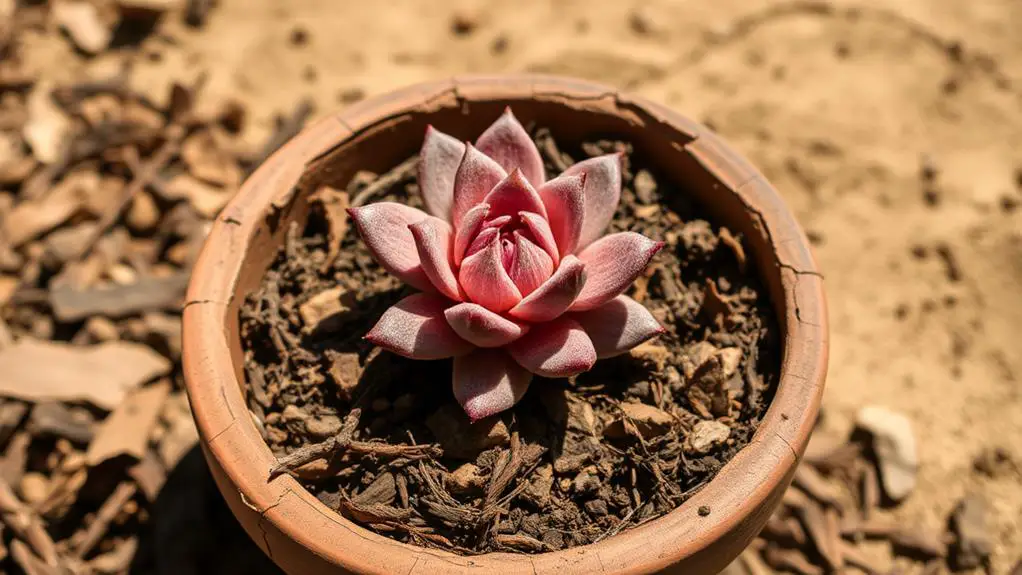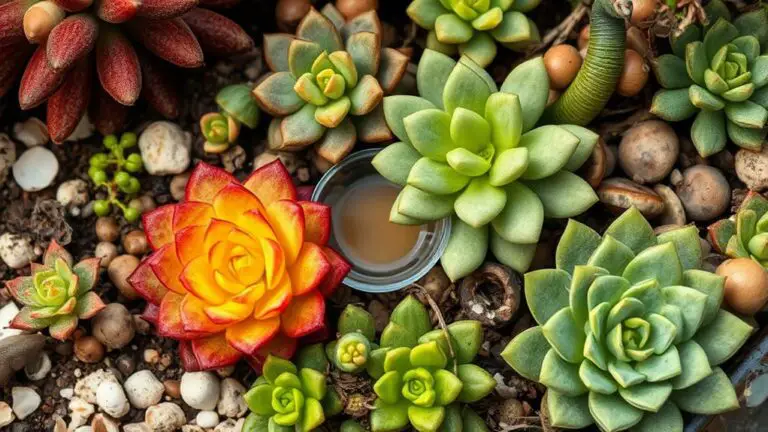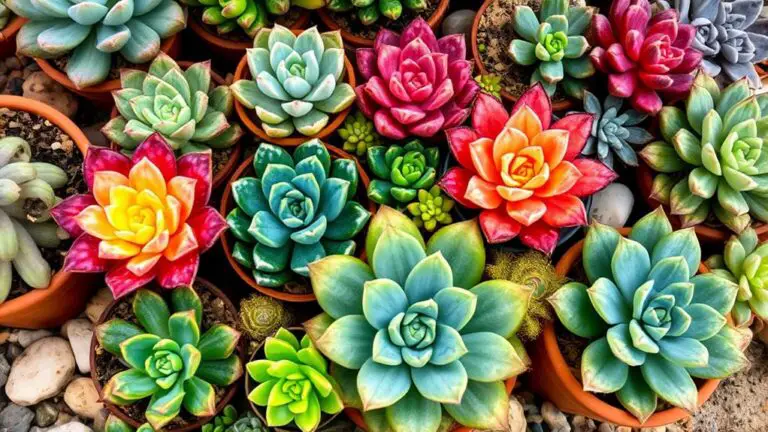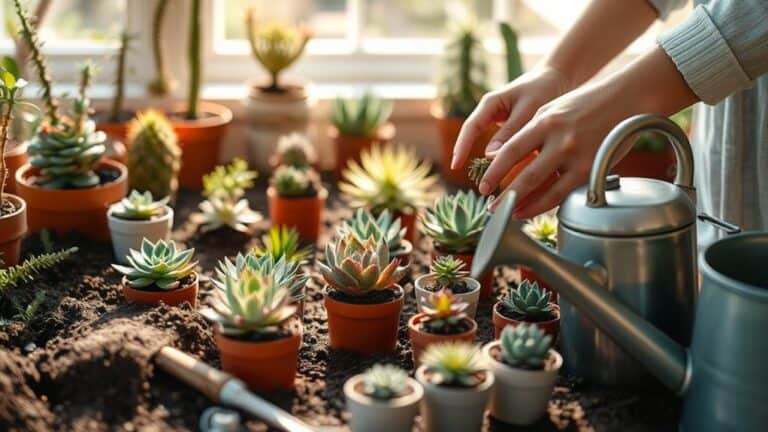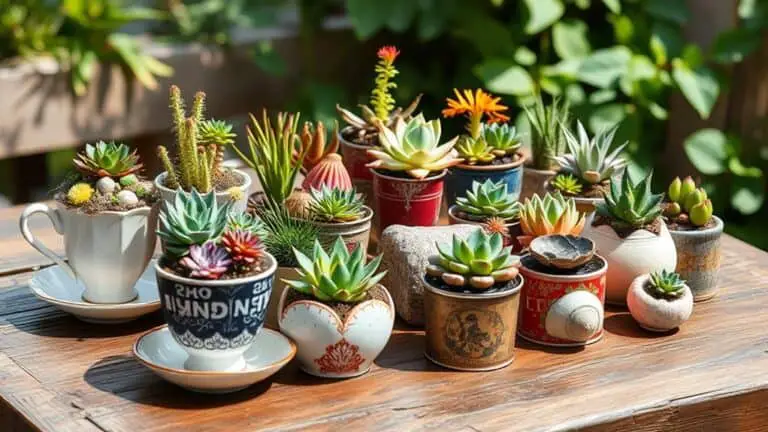Why Isn’t My Succulent Growing?
If your succulent isn't growing, you might be wondering what's going wrong despite your best efforts. It could be anything from inadequate sunlight to improper watering habits, or even poor soil drainage. Succulents need specific conditions to thrive, and any deviation can stunt their growth. Have you considered if your plant is getting enough light or if the soil drains well? Overwatering is another common culprit that can lead to root rot. Curious about other potential issues like temperature or pests? There's more to uncover about what might be holding your succulent back.
Not Enough Space
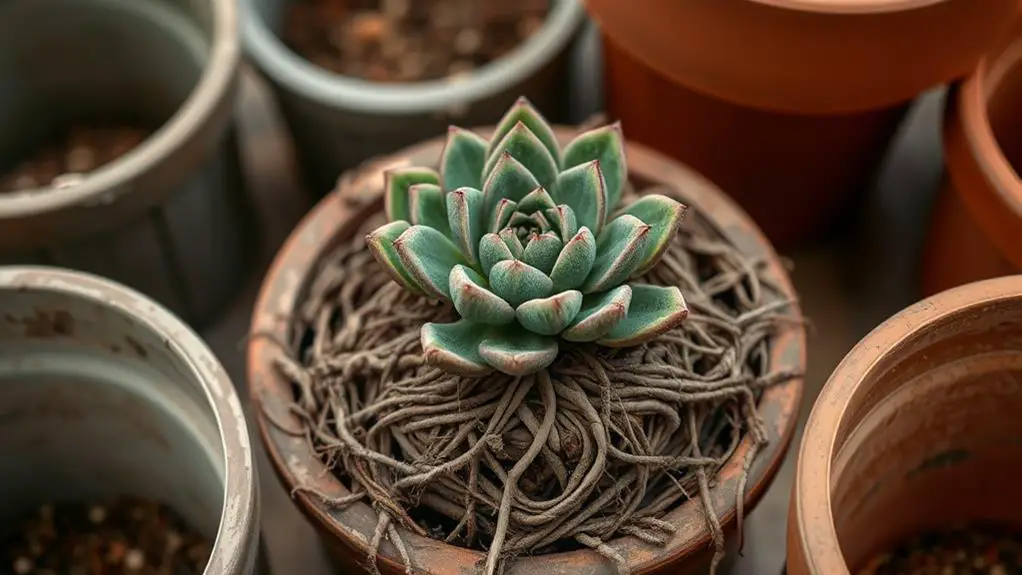
When it comes to succulent growth, adequate space is essential. If your succulents aren't growing, they mightn't have enough room for their roots to spread. Succulents need space to grow properly, and if they're left in the same pot too long, they can become root-bound. This means their roots get compacted, which hinders their growth.
Repotting your succulents every 1-2 years is important. It provides fresh soil and more room for root expansion, which is critical for their overall health. When you repot, gently untangle any knotted or damaged roots. This promotes better nutrient absorption and stimulates growth.
Overcrowding in pots can lead to competition for nutrients. Both the mother plant and any offsets will struggle and slow down their growth rates if they're too cramped.
Regularly checking for signs of root binding, such as stunted growth or difficulty in watering, can help guarantee your succulents have the space they need.
Overwatering or Underwatering

Another common issue that can stunt your succulent's growth is improper watering. Overwatering and underwatering are the main culprits. Overwatering often leads to swollen, translucent leaves and yellowing, which are signs of root rot.
On the flip side, underwatering causes shriveled, brittle, and brown leaves.
To keep your succulent happy, use the "soak and dry" method. This means you should water the plant thoroughly and then let the soil dry out completely before watering again.
Checking soil moisture regularly is vital because watering frequency depends on environmental conditions. In summer, you might need to water every 2-3 weeks, while in winter, it could be every couple of months.
Choosing the right potting mix is also fundamental. Use a mix with perlite or pumice to guarantee good drainage.
Poorly draining soil can worsen watering issues and harm your succulent. Regularly observe your succulent's leaves for any early signs of trouble. This way, you can make timely adjustments.
Poor Lighting

Your succulent mightn't be growing well because it's not getting enough sunlight.
These plants need 6-8 hours of bright, indirect light each day to stay healthy.
Make sure to place them near east or south-facing windows, or consider using grow lamps if natural light is limited.
Insufficient Sunlight Impact
Struggling with insufficient sunlight, your succulent might exhibit pale, leggy growth as it stretches toward any available light source.
When succulents don't get the 6-8 hours of bright light they need daily, they can't maintain healthy growth. You'll notice your plant becoming weak and stretched out. This leggy growth indicates that your succulent is desperately reaching for more light, a clear sign of insufficient light.
To help your succulent thrive, consider placing it near a south-facing window. This spot usually provides the most consistent bright light throughout the day, which is essential for your plant's health.
If you place succulents in shaded environments, they won't get the necessary light and might become stunted.
Optimizing Light Exposure
When enhancing light exposure for your succulents, it's crucial to guarantee they get their essential 6-8 hours of bright, indirect sunlight daily. Succulents thrive under these conditions, and without sufficient light, they can become pale and leggy. This is a clear sign your plants are stretching towards the light source, indicating they need more exposure.
Placing your succulents near east or south-facing windows will provide the ideal light they require. These windows offer plenty of bright, indirect sunlight, avoiding harsh afternoon rays that can burn their leaves. Keep an eye on your plants and adjust their placement as needed.
Seasonal changes can affect the amount of available light in your home. During winter, when daylight hours are short, your succulents mightn't get enough natural light. In such cases, using grow lamps can be a great solution. These lamps supplement natural light, ensuring your plants continue to grow healthily even when sunlight is scarce.
Regularly assess your succulents' light conditions to keep them happy and growing. With the right exposure, your plants will thrive, bringing vibrant life to your home. Remember, good lighting is key to succulent success!
Temperature Issues
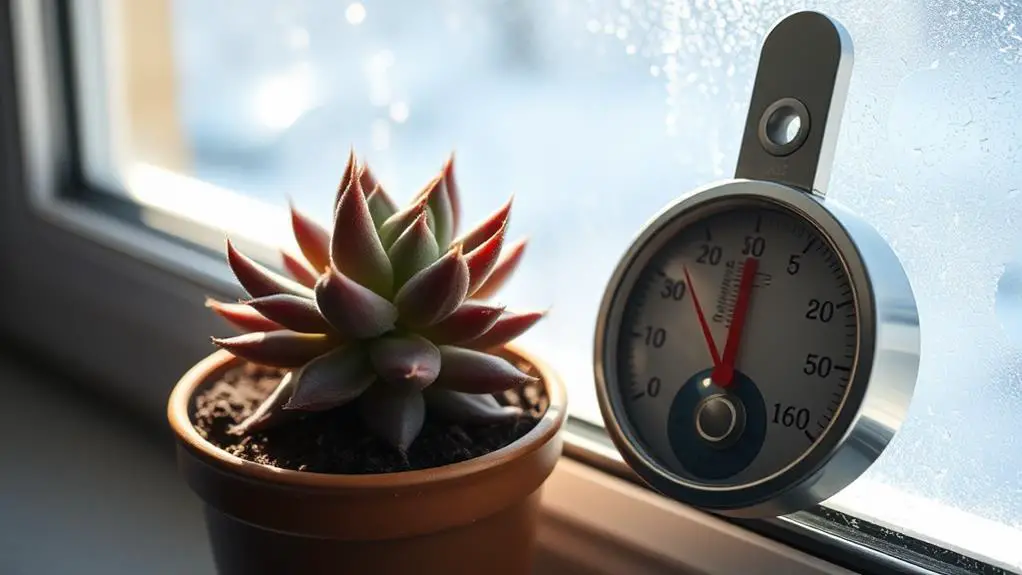
Temperature plays a big role in the health of your succulent.
These plants thrive best between 65°F and 80°F, so keeping them in this range is key.
Avoid exposing them to cold drafts or extreme heat, as this can stress them and stop their growth.
Ideal Temperature Range
Maintaining the right temperature is vital for your succulent's growth. Succulents thrive best at indoor temperatures between 65°F and 80°F, with an ideal temperature around 75°F for peak growth. Keeping the temperature consistent is key. Sudden drops or spikes can stress your plant, leading to issues like root rot or stunted growth.
Avoid placing your succulent near air conditioning vents or open windows, as drafts can cause temperature fluctuations that harm your plant.
In colder months, succulents may enter a dormancy phase, where their growth slows considerably. During this time, they need less frequent watering and adjustments in care. Recognizing this phase helps you provide the right environment for your plant to stay healthy.
Extreme cold or heat can halt your succulent's growth, so it's essential to maintain a stable environment. Make sure the temperature doesn't fall below 65°F or rise above 80°F.
Avoid Temperature Extremes
Understanding the temperature needs of your succulent is just one part of ensuring it grows well. Succulents thrive best at indoor temperatures between 65-80°F. If they face temperature extremes, their growth can halt.
For your succulent's health, avoid placing it near drafts from windows or air conditioning units. These spots can disrupt the stable environments succulents need, causing stunted growth.
Maintaining consistent temperatures is essential. Sudden changes can stress your plant and lead to damage. Cold temperatures below 50°F can push succulents into dormancy, making them decline.
On the other hand, excessive heat can cause dehydration and leaf burn. Both conditions are harmful and can stop your succulent from growing properly.
You should also monitor seasonal changes. Natural light and temperature vary throughout the year, affecting your succulent's growth.
Pests and Diseases

Pests and diseases are among the leading reasons your succulent mightn't be thriving. Common pests like mealybugs, scale, and spider mites can consume your succulent's leaves and roots, causing stunted growth.
Look for signs of pest infestations, such as visible webbing, sticky residue, or a cotton-like substance. These indicators mean it's time for an immediate inspection and treatment.
Diseases such as root rot, often caused by overwatering and poorly draining soil, can also be a major issue. If you notice yellowing leaves and a mushy stem, your succulent might be suffering from root rot.
To prevent this, make sure your plant has good drainage and avoid overwatering. Healthy growth depends on it.
Regular inspections are key to catching problems early. By checking your plants frequently, you can spot pests or diseases before they cause significant damage.
Maintaining good soil drainage and keeping humidity levels low are also essential steps. These practices create a healthier environment for your succulents, helping them to thrive.
Taking these steps will support your succulent's health and encourage robust growth. Remember, a little attention and care can make a big difference!
Dormancy Period
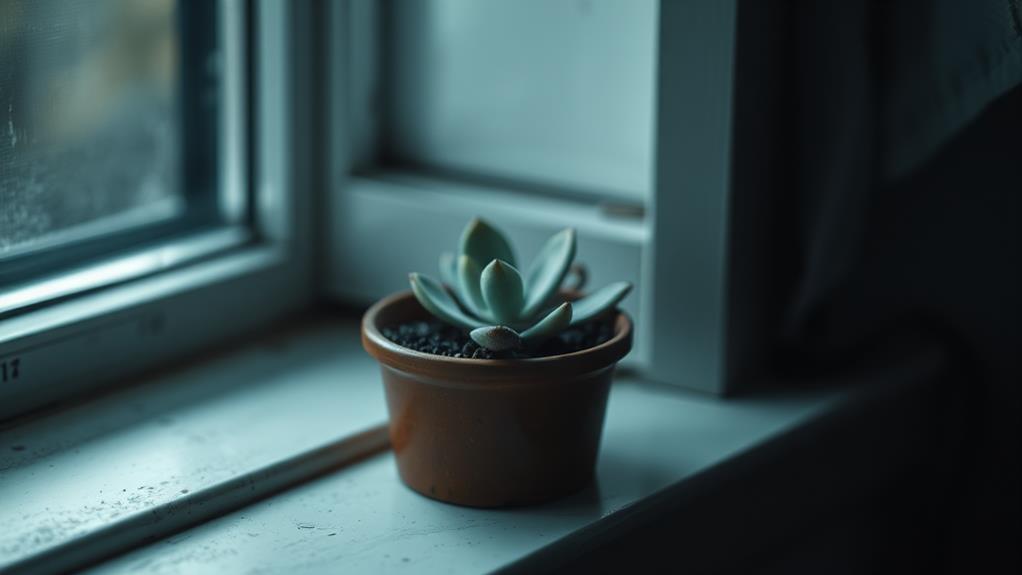
The dormancy period is a natural phase in a succulent's life cycle where growth slows down considerably. Many succulents enter dormancy during the winter months due to lower light levels and cooler temperatures. During this time, you'll notice they don't grow much, if at all. This is because their metabolic processes reduce, allowing them to conserve energy.
Since succulents need less water during dormancy, you should adjust your watering schedule accordingly. Over-watering can lead to problems, so keep an eye on your plant's needs. Typically, the dormancy period lasts from late fall until early spring, but it can vary depending on the specific species and environmental conditions. Some succulents, especially those from cooler climates, may even go dormant in the summer to escape extreme heat.
Understanding your succulent's dormancy cycle is essential for proper care routines. During this period, give them less water and avoid fertilization.
Make sure they still receive some sunlight, but be mindful of the temperatures they're exposed to. Keeping them in a stable environment will help them thrive once the growing season returns. By adjusting your care routines, you'll support your succulents' health throughout the year.
Soil and Drainage
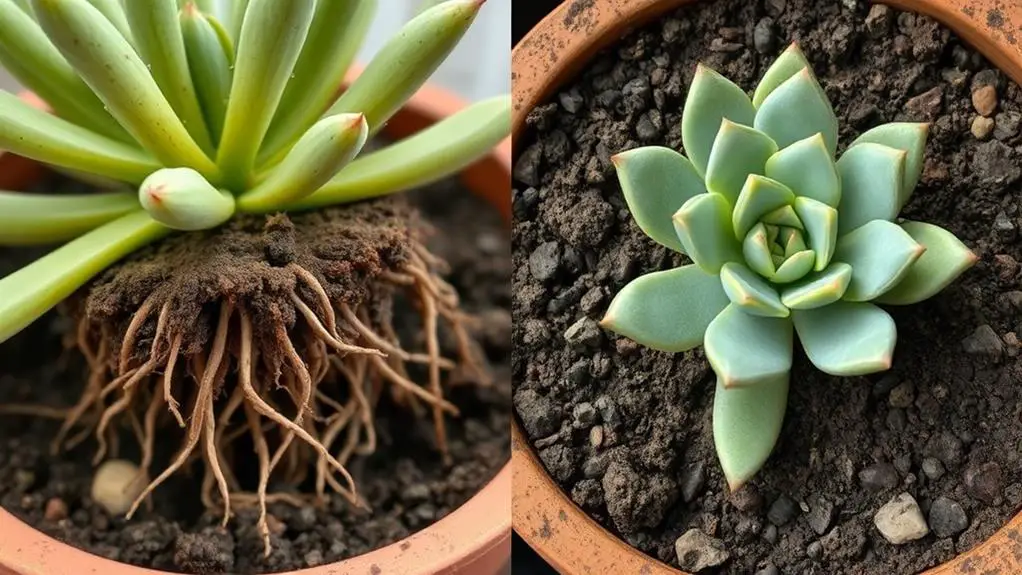
If your succulent isn't growing well, soil and drainage might be the culprits. Succulents need well-draining soil to thrive. A mix of coarse sand, perlite, and fine gravel creates the perfect environment by preventing waterlogging, which can lead to root rot.
It's also important that the soil contains minimal organic matter to reduce mold and pest issues.
When repotting your succulent, choose pots made from terracotta or ceramic. These materials help excess moisture escape thanks to their drainage holes. This is vital because succulents don't like to sit in wet soil.
Always check the soil moisture before watering. Let the soil dry out completely between waterings to keep the roots healthy and promote growth.
Aerating the soil helps, too. By gently poking holes in the soil, you increase oxygen levels, aiding nutrient absorption and encouraging better growth.
Remember to repot your succulent with fresh, well-draining soil every so often to refresh the environment for the roots.
Root Development
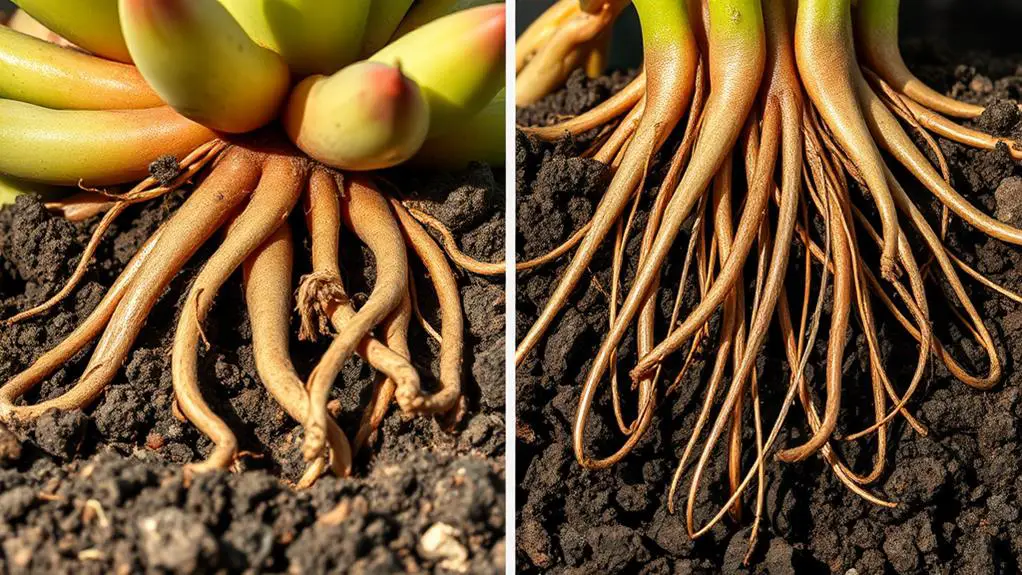
Ensuring your succulent has the right soil and drainage sets the stage, but root development is just as important for healthy growth. Healthy root development is essential because it impacts your succulent's ability to absorb water and nutrients. To support this, you should repot your succulent every 1-2 years. This prevents root binding, where roots get too compacted and limit growth.
During repotting, check and untangle the roots. This promotes better nutrient absorption and overall plant health. Using a shallow, wide pot can help the root system expand without retaining too much moisture. Excess moisture can harm succulents, so this step is necessary.
| Factor | Impact |
|---|---|
| Repotting frequency | Prevents root binding |
| Untangling roots | Enhances nutrient absorption |
| Shallow, wide pot | Supports root expansion |
| Offsets separation | Avoids nutrient competition |
| Moisture management | Prevents excessive moisture |
Separating offsets or baby plants from the mother plant is another key step. Offsets mature better on their own and won't compete for nutrients. This allows both the mother plant and offsets to develop robust root systems.
Encouraging Growth
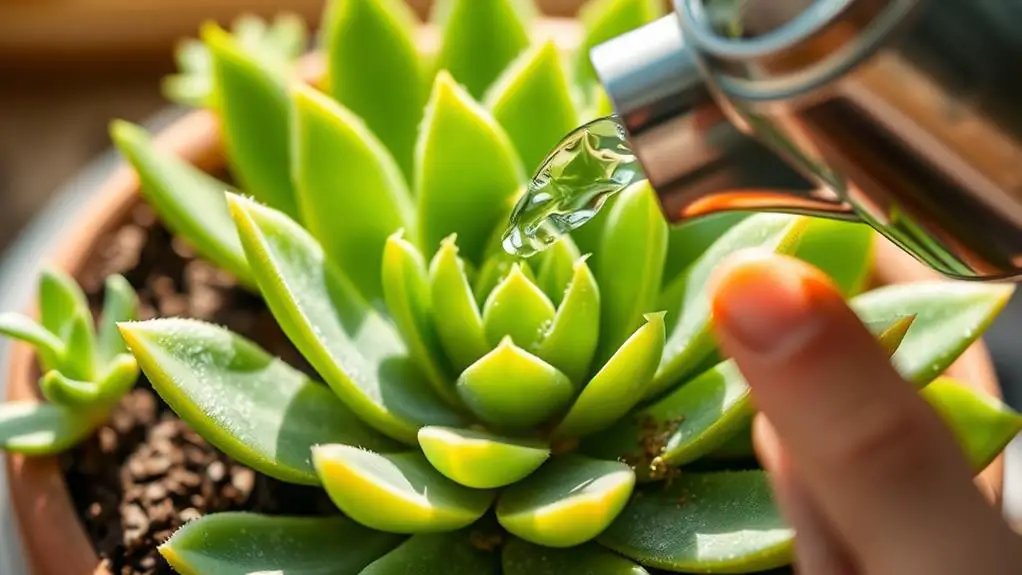
Getting your succulent to thrive involves understanding a few key principles. First, make sure your succulent gets plenty of sunlight throughout the day. Aim for at least 6-8 hours of bright, indirect sunlight. Without enough light, your succulent can become leggy and its growth may slow down.
Next, it's vital to water your succulent correctly. Use the "soak and dry" method. Water thoroughly, then let the soil dry completely before watering again. This approach prevents overwatering, which can lead to root rot.
Also, repot your succulent every 1-2 years to keep the roots healthy. Use a well-draining soil mix with perlite or pumice to encourage new growth.
Keep an eye on the temperature. Succulents prefer indoor temperatures between 65°F and 80°F. Avoid placing them near drafts or extreme temperature changes, as this can halt their growth.
Lastly, regularly check for pests. Infestations can stunt growth and harm your plant's health. If you spot any pests, treat them promptly to keep your succulent thriving.
Frequently Asked Questions
How Do You Encourage Succulents to Grow?
Make certain your succulents get 6-8 hours of bright, indirect sunlight daily. Use well-draining soil, water using the "soak and dry" method, repot every 1-2 years, and check for pests to encourage healthy growth.
Why Is My Succulent Not Growing?
You might need to repot your succulent if it's root-bound. Make certain you're watering properly, providing enough light, and keeping the temperature stable. Check for pests or diseases, which can also halt growth.
How to Speed up the Growth of Succulents?
To speed up succulent growth, make certain they get 6-8 hours of bright, indirect sunlight daily. Use a well-draining potting mix, water with the "soak and dry" method, and repot every 1-2 years for ideal conditions.
How Often Should Succulents Be Watered?
You should water succulents every 2-3 weeks during their growing season and less often in winter. Use the "soak and dry" method: water thoroughly, let the soil dry completely, and check moisture regularly to avoid overwatering.
Conclusion
Don't worry if your succulent isn't growing—you're not alone, and you can fix it! Check its light, water, and soil conditions to guarantee they're just right. Make sure it has enough space to grow and watch out for pests or diseases. Remember, succulents sometimes need a rest period, so patience is key. With a few adjustments and a bit of care, your succulent will thrive. Keep going, you've got this!

